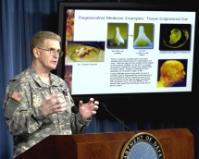The Armed Forces Institute of Regenerative Medicine -- an alliance of the military services, the Veterans Administration, the National Institutes of Health and around 250 doctors and researchers at 30 universities and hospitals -- formed in early 2007 with $50 million a year in government and private funding. Lt. Gen. Eric Schoomaker, the Army's top doctor, formally inaugurated the Institute at a Pentagon event on April 17. This summer the institute will launch its first research programs, aiming to "put people back together" after nearly catastrophic injuries, according to Army Col. Robert Vandre, the Army's senior official for "combat casualty care research."
Today, Stewart is a poster boy for the Army's latest generation of "intelligent" robotic limbs that move and flex like real limbs -- and adapt themselves to a wearer's unique gait. Prostheses have come a long way since the wooden peg leg, but in the future they might not be necessary at all. One military medical institute is working to grow new body parts from human and animal "seed" tissue.
Keep reading for free
Already a subscriber? Log in here .
Get instant access to the rest of this article by creating a free account below. You'll also get access to three articles of your choice each month and our free newsletter:
Subscribe for an All-Access subscription to World Politics Review
- Immediate and instant access to the full searchable library of tens of thousands of articles.
- Daily articles with original analysis, written by leading topic experts, delivered to you every weekday.
- The Daily Review email, with our take on the day’s most important news, the latest WPR analysis, what’s on our radar, and more.

